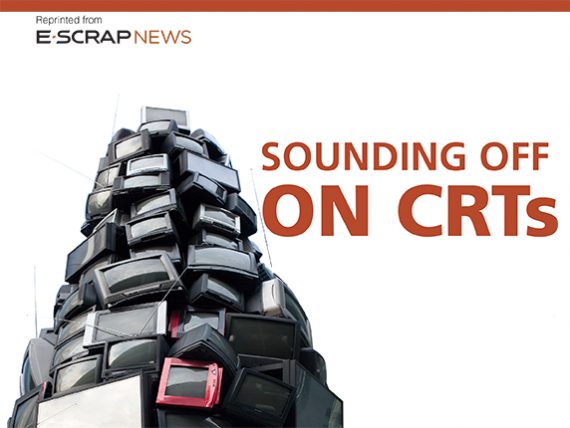
This story originally appeared in the March 2017 issue of E-Scrap News. Subscribe today for access to all print content.
Has the industry made real progress on the CRT issue? It’s tough to say. Certainly, dialogue has been plentiful, stakeholders have pushed for adjustments in state programs, and technologies to more cost-effectively handle glass have been proposed – and in a few cases, actually implemented.
But by and large, the same CRT barriers that thwarted industry players a half decade ago are still in place, and CRT stockpiles continue to pop up.
To help processors and others re-center themselves amid the ongoing discussion, E-Scrap News elicited perspectives from three distinct stakeholders: a trade association leader, a representative from a processor that works closely with lead smelters, and a European executive whose company uses CRT glass in tile manufacturing.
In their op-eds, these individuals focus specifically on final disposition options for CRT glass. All the outlets discussed are actively taking in CRT material and helping to relieve the e-scrap industry of the ongoing stockpiling problem. But all the options also carry questions in terms of pricing, capacity and environmental impacts.
These perspective won’t immediately solve the industry’s CRT dilemmas. But they do help provide clarity on how markets are developing. Such insight is key to moving ahead, even if such progress happens slowly and with great debate.

Robin Wiener, ISRI
The View from ISRI: It’s time to bury the landfill option for CRTs
Even after being in the scrap recycling industry for over 25 years, I am still amazed at how often we have to reeducate policymakers about the business. Despite long-standing industry efforts to distinguish scrap recycling from waste disposal, many still confuse scrap recyclers with solid and hazardous waste companies.
Regulators, especially at the state and local levels, see secondary materials being used as inputs at recycling operations and reflexively tend to regulate materials as solid or hazardous waste, or they deem recycling facilities as solid or hazardous waste facilities without understanding the specifics of the operations.
For instance, during the recent federal rulemaking on the Definition of Solid Waste, the proposed rule included several unnecessary, onerous requirements for recyclers of scrap metal that were based on regulators’ misunderstandings about recycling.
Leading up to the creation of the final rule last year, the Institute of Scrap Recycling Industries met with the Environmental Protection Agency to clarify how the industry operates and recycles scrap metal. The eventual final rule essentially maintained the pre-rulemaking federal exclusion and exemption for recycled scrap metal, as well as the conditional recycling exclusions from solid waste for CRTs and CRT glass.
Undermining 20 years of CRT efforts
Given all this recent activity and focus, imagine how surprised and somewhat dismayed we are to learn that certain original equipment manufacturers (OEMs) and their contractors are now asking to get recycling credit when CRT material is used as alternative daily cover at disposal sites or placed into “retrievable storage” at landfills.
These activities are not recycling, and they undermine 20-plus years of efforts by policymakers, NGOs and the recycling industry to keep CRTs out of the landfill.
Our members understand that CRTs are tough to recycle because of the costs. Unlike more traditional streams, such as used vehicles and refrigerators, there is a cost to responsibly recycle the leaded glass from a CRT, and nobody wants to pay more.
In this instance, ISRI supports policy that requires the OEMs to pay for the collection and recycling of a negative-value product. And 24 states have agreed with us. As a means to enhance the recycling of the metal (which accounts for 29 percent of the weight of a typical used CRT monitor), plastic (13 percent of a monitor) and glass (around 58 percent of a monitor), OEMs have a statutory obligation to foot the bill.
Furthermore, there are increased concerns about the downward economic pressure that many state OEM take-back laws have had on the CRT glass market.
While we support a competitive marketplace, we cannot tolerate policies and state OEM action plans that have effectively driven the CRT market into stockpiled warehouses across the country. We know that OEMs are not solely to blame. Recyclers have taken bad deals that they should not have accepted, and state enforcement has been extremely lax. In addition, the federal speculative accumulation rule has acted as an enabler to legally move piles around from one warehouse to the next.
OEMs should cover actual costs
So what’s the solution? The solution is to recycle the glass. OEMs must be required to pay the actual costs associated with recycling CRT monitors. Recyclers must stop taking deals that do not cover the actual costs. State and federal enforcement needs to be dramatically enhanced.
The idea that approved OEM plans can allow CRTs to be stockpiled in warehouses with little to no hope of recycling makes a mockery of the entire program.
We all know the global market has changed. Glass-to-glass manufacturing markets have been replaced with glass-to-lead, glass-to-copper, and glass as a raw material substitute to make ceramics and tiles. But the issue is still about costs, not capacity. We should not allow companies to hide behind the argument that these markets are inadequate in order to shirk their fiscal and statutory responsibilities.
Similar to the hard-fought CRT glass exclusion, companies have relied on the state programs to invest in technologies and business models designed to responsibly recycle CRT monitors. Undermining such investments and 20 years of pro-recycling policy is not the solution. Nor is allowing OEMs or any of their downstream recyclers to get recycling credit for putting a CRT monitor into a landfill in one form or another.
We can and should expect much more as a recycling industry. The longstanding ISRI policy that “scrap is not waste, and recycling is not disposal” should continue to be the guiding principle.
Robin Wiener is the president of the Institute of Scrap Recycling Industries. She can be contacted at [email protected].

Tom Bolon, Novotec Recycling
View on CRTs: Lead smelters want your recovered glass
Let me cut to the chase: There is plenty of capacity at lead smelters in North America to fully recycle the lead from collected CRT glass.
We have all heard from one source or another that the smelters are either shutting down or drastically lowering their capacity to process leaded CRT glass. This is not true.
Right now, North American smelters have the capacity to receive thousands of additional tons of leaded glass, and there will continue to be capacity well into the future. The smelters are in this CRT consumption position because there is demand for the lead that the smelters are able to extract.
Your leaded CRT glass is needed to supply lead for the medical field, battery manufacturers, the defense sector and other industrial applications. For instance, radiation shielding material containing recycled lead from CRT glass is being installed in new and renovated medical facilities across the country. In addition, batteries making use of recovered lead are being manufactured and put to work in a slew of ways, including the storage of renewable energy.
To put some numbers behind my argument, I’ll offer the following: Novotec Recycling, the company I represent, has the capacity to process an additional 50 million to 75 million pounds of CRT material in 2017 and send it directly to our downstream partner, Glencore’s lead-smelting operation in New Brunswick, Canada.
And Novotec is not the only recycling company working with a smelter. There are additional smelters located in diverse geographical areas in North America and other Organization for Economic Cooperation and Development (OECD) countries.
Furthermore, moving CRTs to smelters for final disposition is comparable from a cost perspective to other accepted CRT downstream options, and smelters offer a recycling outlet that’s in full compliance with all state and federal rules and regulations.
Don’t let facts drop out of the conversation
My goal here is not to make an ethical or moral judgment regarding the difference between using a smelter and using any other approved CRT downstream. That’s a subject and debate for another article and one that I encourage to be undertaken.
My goal at present is simply to make sure that in any debate on the options for recycling CRT glass it is understood that capacity at the smelters is not the issue. And if someone tries to convince you otherwise, they’re simply not telling the truth.
Anyone faced with the challenge of handling CRT glass — from original equipment manufacturers and state and local recycling programs to e-scrap companies of all shapes and sizes — knows it can be tricky. We’ve seen countless companies try and fail to handle CRT glass by cutting corners and costs and we’ve seen many more entangled in regulatory disputes and challenges. But this industry is going to keep seeing CRT devices for a long time to come and it’s imperative we make well-informed decisions in how we choose to handle the material.
What can’t be lost in the conversation is the fact that there are downstream recycling options to consider. One of those options is sending the CRT glass to a lead smelter. This option is readily available today and will continue to be into the foreseeable future.
Tom Bolon is the CEO of Columbus, Ohio-based Novotec Recycling.

J.J. Santos, Camacho Recycling
View on CRTs: The proven benefits of the tile option
In developed countries, the ceramics industry is one of the sectors with the highest investment in innovation aimed at limiting the environmental impacts of its activities. Those activities require both large consumption of raw materials (clays and feldspars, among others) and energy.
The ceramics sector is always looking to innovate to remain in compliance with strict laws and to protect the environment. That’s the case not only in the manufacturing process but throughout the supply chain, including the supply of raw materials, transportation, end products, final uses and more. In the search for this sustainability, the ceramics sector has found a solution in using recycled CRT glass as a secondary raw material.
Spain manufactured 4.7 million square feet of tile in 2015, more than any other European country. The use of CRT glass in ceramics is a reality there.
Life ClayGlass, a European project co-financed by the European Commission, is one of the most recent initiatives to prove the socioeconomic and environmental advantages of using properly handled CRT glass as a secondary raw material. This three-year project, which ended in December, was coordinated by the Spanish Asociación para la Investigación y Desarrollo Industrial de los Recursos Naturales (AITEMIN). The European Commission provided 988,611 euros (more than $1 million) out of the total 1.98 million euro project budget.
Five to 10 percent CRT material
Life ClayGlass tested mixing clays with recycled CRT glass, both leaded and unleaded. By using 5 to 10 percent recycled CRT glass in ceramic tiles, it is possible to reduce the required cooking temperatures and, consequently, reduce carbon dioxide emissions. The energy savings during the firing of ceramics can also range from 5 to 10 percent, depending on the percentage of recycled glass allowed by the ceramics mass.
The decrease in furnace temperatures ranges from 212 degrees Fahrenheit to 302 degrees Fahrenheit. In total, the savings of manufacturing costs could be around 7.5 percent. Additionally, testing in the furnace chimneys verified that the emissions remain as clean as before the glass was used and within European Pollutant Emission Register thresholds.
Other benefits are the reduced use of natural raw materials, such as clays and feldspars, during the ceramics manufacturing process. Using recycled CRT glass also keeps it out of landfills, where it presents risks to the environmental and nearby populations.
Besides Life ClayGlass, there are other serious projects supporting the use of recycled CRT glass in the ceramics industry. The Ecovitrum project was designated one of six “Best of the Best” Life Environment Projects 2013. The project’s main objective was to demonstrate the possibility of apply a new integrated management model and technology for CRTs that enables them to be used in new products, including ceramics.
The project showed that CRT glass can be optimally used in the ceramics components industry as a substitute for commonly used raw materials, because of its similar chemical composition. Doing so transforms a waste into an economically viable resource. It was initially possible to replace 15 to 25 percent of natural raw materials with CRT glass, resulting in reductions in the consumption of silica, barium and strontium oxides, in full compliance with the aims of the flagship initiative for a resource-efficient Europe. The project managed to reduce carbon dioxide emissions by two metric tons (based on the estimate that recycling a TV or monitor involves a reduction of 46 pounds of carbon dioxide because materials do not need to be manufactured).
Worker safety a priority
These innovations are carried out within the framework of regulations for each of the production phases: materials use, handling, installation and transportation of both raw materials and final products. Specifically, and in a more exhaustive way, they comply with regulation related to the safety of workers. For instance, in the case of leakage in glazed tiles that include CRT glass, it is demonstrated that lead stays inert and remains distributed throughout the whole ceramic dough.
Later, when the tiles are broken during a demolition or cut during installation, the lead in the dust does not present a risk to consumers or workers. That’s because only a tiny portion of the tile is lead. Hazards can come from breathing enormous amounts of dust, but not because of the tiny quantity of lead in the dust.
One of the advantages of a globalized world is the possibility of participating in the best-available technologies wherever they are located. That guarantees the profitability of the companies involved and the environmental benefits derived by the technologies. Moreover, rail and ship transportation are considered environmentally friendly modes of transportation because of their high energy efficiency and low carbon dioxide emissions, compared to emissions from truck transportation.
For all of these reasons, ceramic manufacturing should be considered a positive downstream option for CRT glass.
J.J.Santos is the international manager of waste electrical and electronic equipment at Camacho Recycling, located in Spain. He can be contacted at [email protected].

